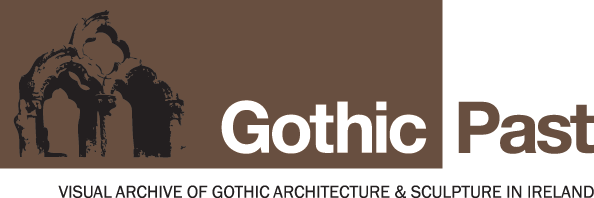Browse Items (191 total)
Sort by Title [A-Z] | [Z-A]
St. Mary's Collegiate Church, Youghal, south choir wall, window rear arch
Rear arch of south windows, mouding comprises: double ogee running along chamfer plane.
St. Mary's Collegiate Church, Youghal, south choir wall, sedilia, base
Round base of sedilia, moulding from top down comprises: roll, bell, roll, roll, bell, free-standing fillet, hollow, plinth. A Perpendicular style base resembling others at the site. This base is round, making it even more unusual.
St. Mary's Collegiate Church, Youghal, south choir wall, sedilia, capital
Round capital of sedilia, from top down moulding comprises abacus, chamfer, hollow, roll, fillet, bell, necking roll. This capital is unusual not only because it is round rather than the usual polygonal shape, but because the moulding elemets are small in scale and finely cut.
St. Mary's Collegiate Church, Youghal, south choir wall, sedilia, jamb, arch and hood
Jamb, arch and hood moulding of sedilia. From intrados moulding comprises: ogee roll-and-fillet, quadrant, double ogee. The hood, from the outer to inner face reads: chamfer, ogee, hollow chamfer, ogee. This is an unusual moulding, in scale and in variety of elements. It resembes the west door moulding of Abbeydorney Cistercian Monastery and these…
St. Mary's Collegiate Church, Youghal, south transept, wooden screen, door jamb
Door jamb of wooden screen in south transept. From intrados, moulding comprises: quadrant, fillet, ogee.
St. Nicholas Collegiate Church, south transept, east wall, Joyce tomb, base
Base of tomb niche jamb. Moulding comprises from top down: grooved roll, bell, flat surface at right angle, hollow chamfer, quadrant, flat surface, bell, flat surface at right angle, quadrant, hollow chamfer, plinth. The mouldings here are unusual, the two lower elements protrude from the bell as two square blocks with mouldings at their front…
St. Nicholas Collegiate Church, south transept, east wall, Joyce tomb, capital frieze
Capital frieze of Joyce tomb, which runs horizontally between the jamb and arch. Moulding comprises, from top down: roll, bell running into roll, free-standing fillet, roll, fillet, hollow chamfer, roll, hollow chamfer. This tomb is thought to be very late, and have almost classical mouldings.
St. Nicholas Collegiate Church, south transept, east wall, Joyce tomb, chest
Moulding of tomb chest, moulding comprises: freestanding fillet, double ogee. Ogees are unusual and often occur in conjuction with Flamoboyant tracery.
St. Nicholas Collegiate Church, south transept, east wall, Joyce tomb, mullion
Mullion of Flamboyant tracery of tomb niche. Moulding comprises: central roll-and fillet flanked at either side by hollow chamfers.
St. Nicholas Collegiate Church, west exterior wall, door, jamb and arch
West door that terminates central aisle, centre of three gabled front. Broad splay. Moulding fron intrados comprises: chamfer, hollow, roll-and-fillet, hollow chamfer, roll-and-fillet, hollow chamfer, roll-and-fillet, hollow chamfer, roll-and fillet, hollow, chamfer. The mouldings here are broad, and similar examples of this roll and fillet are…
St. Sepulchre's Archiepiscopal Palace, Hugh Inge's Door, jamb and arch
Door jamb and arch moulding comprising: hollow chamfer, quadrant. The door was inserted by Archbishop Hugh Inge in 1523 and restored in the eighteenth century. Fragments of window found during recent excavations have the same scale moulding and are likely to associated with the door. The door is unusual in that it has a three centred head.
Timoleague Franciscan Friary, north choir wall, tomb niche, architrave
Architrave framing tomb niche. Badly weathered, moulding comprises central roll, flanked at either side by flat surface, shallow roll.
Timoleague Franciscan Friary, north choir wall, tomb niche, base
Base of tomb niche jamb, moulding from top down comprises: roll, convex surface.
Timoleague Franciscan Friary, north choir wall, tomb niche, capital
Capital of tomb niche jamb. From top down, moulding comprises: chamfered abacus, wave, roll, fillet, bell, roll.
Timoleague Franciscan Friary, north choir wall, tomb niche, hood
Hood moulding of tomb niche. From upper face down and inward the moulding comprises frontal fillet, quadrant, hollow chamfer, flat surface.
Timoleague Franciscan Friary, north choir wall, tomb niche, jamb and arch
Jamb and arch moulding of tomb niche, from intrados moulding comprises chamfer, quadrant, hollow chamfer, broken quadrant.
Timoleague Franciscan Friary, north choir wall, tomb niche, tracery bar
Tracery bar of tomb niche. Moulding comprises: centre frontal roll flanked at either side by hollow chamfer, quadrant. They rear of the tracery bar is rectangular.
Timoleague Franciscan Friary, north nave wall, tomb niche, base
Base course running along jamb of tomb niche. The moulding comprises: chamfer, chamfer, chamfer. The mouldings may have been more distincitve but they are now very worn.
Timoleague Franciscan Friary, north nave wall, tomb niche, capital frieze
Capital frieze running along jamb of tomb niche. Moulding from the top down comprises: chamfer, frontal fillet, angle-fillet, fillet, angle-fillet, flat surface, angle-fillet, fillet, flat surface. The lower secion can be read as a stepped rebate.
Timoleague Franciscan Friary, north nave wall, tomb niche, capital frieze
Capital frieze running along jamb of tomb niche. Unusual moulding from the top down comprises quarter roll, fillet, bell, roll, roll.




















